What is Plum Concrete?
Important Point
In mass concrete foundations, boulders of say 150 mm size up to 30% of the total quantity of concrete, are mixed in the wet concrete. This adds to economics and saves heat generation. Such concretes are called plum concretes.
After at least two layers of wet concrete is completed, well-shaped and thoroughly washed, angular rock pieces using a maximum size of not more than 60% of a layer of pour thickness are placed in the concrete, keeping a distance of more than one-and-a-half times of the biggest size of aggregates in the concrete.
The bottom of the boulders should be embedded in the wet concrete to avoid voids at the bottom. Concreting is continued without stopping.
These rock pieces become an integral part of a concrete structure.
Also, read: Piling for Foundation | Use of Pile Foundation | Characteristics of Pile Foundation
Difference Between PCC Concrete and Plum Concrete
Plum Concrete
- Plum Concrete normally use on the uneven surface of the ground and another area. This uneven surface level by plum concrete. This method to reduce the cost of construction.
- Because of plum concrete, you are using large material part near about 60% of Stone and 40 % of concrete so this method to use cost-efficient in construction.
- Plum concrete original concept by the aggregate in concrete. This plum concrete use a maximum of 300 mm size aggregate
Also, read: Test for Compressive Strength of Brick | Water Absorption | Dimensions Test
P.C.C (Plain Cement Concrete)
- P.C.C (Plain Cement Concert) is a base of concrete. Commonly use of PCC all construction work. P.C.C is a mixture of cement, water, fine aggregate, coarse aggregate, and water this simply mixture called P.C.C
- M 7.5, M 10 both grades of Plain Cement Concrete
- Use of P.C.C it is as a protective layer for the RCC above so that water from the RCC is not absorbed bt the earth below
- Moisture available in soil should not be absorbed by RCC footing which causes correction of reinforcement
- Provided a base for the concrete and also helped workers to set out the structure above in easied way.
Also, read: What Is Traversing in Surveying | Types | Method | Definition
Application of Plum Concrete
- Normal use plum concreter below footing as a base of footing, so that water from the footing is not absorbed bt the earth below.
- Plum Concrete can be utilized in areas that need massive concrete placements such as concrete dams or bridge piers. In these instances, pieces of stone roughly 150millimeters in size function as coarse aggregates to mix a plum concrete.
- Plum concrete using 150 mm size plums and with an effective cement content of 177 Kg/m3 was used for the construction of an original dam.
- It was thought that using the state-of-the-art high-speed mixers of sufficient capacity, a more cohesive concrete mix of 150 MSA could be obtained very easily.
- Similarly, in a different case, suppose the foundation pit for the bed of a machine is suggested to have a particular thickness; however, the hard stratum can be found in 3 m below the bottom level.
- Whereas in layout It had been suggested that the depth of foundation for bed could be 1.5 m.
- Considering that the foundation needs to be rested on the hard strata of soil, therefore plum concrete of thin ratio using 80mm -100millimeter size stones will be poured that is rammed up to 1.5 m and subsequently ordinarily designed raft, footings might be laid.
Also, read: What is Chain Surveying (Principal, Procedure, Method, Instrument)
Purpose of Plum Concrete
Plum concrete is used to attain the required surface-level below the foundation and footing. It is used to lessen the cost of PCC if the required thickness of PCC is large. Primarily it is used in mass concreting work such as side slops, barrier, and gravity dams.
For instance, in the construction of a residential building, the small area under a footing is too steep, then to use plum concrete.
Mix Design of Plum Concrete
- PPC Cement 53 Grade: 220 Kg
- Water Cement ratio (w/c) : 0.6
- Free Water: 132 liters
- 300 mm Metal: 666 kg
- 20 mm Aggregates: 666 Kg
- 10 mm Aggregates: 539 Kg
- Fine Aggregate (Sand):1038 Kg
- Admixture Dosage :0.6%
- Admixture: 1.4 liter
- The density of Concrete: 2596 Kg/cum
You’re able to alter the mix design by altering the specific gravities of materials that can help it become applicable in accordance with the substance available at your location.
Changing that specific gravity will change the weight of material in mix design that is automatically calculated.
Do not use these mixes directly without doing prior trials of it; the data provided is for educational and better understanding of mixes.
After doing a trial, if any issue observed, you can make a modification by adjusting the % of each size of aggregate to attain the required properties of fresh concrete.
To ensure a total of all aggregate percentage in a mix should some to 100%
In general, for direct placement concrete
A ration of fine aggregates to coarse aggregates kept between 35:75 to 40:60
Also, add stone of total wattage of all concrete 40% near about 666 kg of plum(Stone) in Plum concrete
In the case of pump concrete, the fine content is kept over 45%
You’ll be able to adjust the percentages of fines and coarse by taking a look at the concrete produced during trial.
Admixtures play an important role in the properties of fresh concrete, especially in retention and workability.
Do select admixture properly to ensure no failure during the real usage of concrete.
All can answer to the thread with their mix design of the same grade; this can help others to understand design in a better way and certainly will do a cost optimization.
Also, read: M30 Mix Design
Methodology of Plum Concrete
1. Transportation of Plum concrete:
The boulders are the size of a boulder (Size) near about 300 mm, which may be lifted by laborers easily, not too big or small. maximum
2. Before Placing of Plum Concrete in Leaving and Cleaning:
- The very first step that’s done initially is cleaning and leveling of the surface by the elimination of soft soil, which could lead to low bearing capacity.
- After clearing and grubbing, water is sprayed on the surface to allow it to be moist before placement of plum concrete.
- The cause of sprinkling water would be to ensure a proper bond of plum concrete together with the ground surface.
- Following a sprinkling of plain water anti-termite compound is sprayed, which is essential today for the perfect foundation of a structure.
3. Pacing and Spreading:
- Boulders are spread across the ground with very little gapping layer by layer, and concrete has been spread with pump all over the boulders in each layer, which slowly permeates within the gapping between boulders.
- This will help to bind it properly, after pouring concrete, boulders are thrown to the concrete, and the process repeats till the required level surface is reached.
4. Plum Concrete Curing:
- Curing ought to be done for the next 7 days minimum. Jute bags are spread over the entire area of plum concrete to retain moisture for quite a while after curing.
Also, read: Procedure for Rcc Concrete
Details & Specification of Plum Concrete
- Each layer plum concert maximum height 900mm did not exceed more hight in one layer
- Maximum crevices in one layer 150 mm only
- The volume of the plum from the concrete will not exceed 40% (percent) of overall volume.
- Plum concrete in use maximum M10 Grade concrete in this concrete aggregate of maximum size 25mm.
- Plum will comprise of black trap basalt of crushing strength of minimum 100 Kg /Sq.cm.
- Plum concrete density 1650 kg/Cubic.meter
This nominal maximum size of coarse aggregate should be as big as possible within that the limits given but in no case greater than one-fourth of their minimum thickness of this member, provided the concrete may be placed without difficulty so as to surround all reinforcement thoroughly and fill the comers of the form.
In terms of the need of the aggregate size, which may be utilized from the plum concrete, there are different recommendations from the IS code; the code says that for most of the common works that the size of 20 aggregates is best and suitable.
If there are not any restrictions for the flow of concrete to part 40 mm or larger is also utilized. However, where you will find reinforcement or the cover is small with all the formwork, 10 mm nominal maximum size plums should be used in plum concrete.
Plums above 150 mm and around any reasonable size could possibly be utilized in plain concrete work up to a maximum limit of 20 percent by volume of concrete if specifically permitted by the engineer-in-charge.
But for all the cases, the plums will likely be dispersed evenly and will not be closer than 150 mm from the surface.
Plum Concrete
It is formed by amalgamating coarse aggregate and cement which are set underneath the foundation or footing of a structure in order to attain a level surface for allocating the load equally. The plum concrete is actually an inexpensive variation of mass concrete.
What Is Plum Concrete?
Plum concrete is an economic adaptation for mass concreting. Plums volume should not pass 30% – 40% of the total finished concrete volume. Plum concrete also refers to Cyclopean Concrete or Rubble concrete. It should not be greater than one-third of the concrete mixer cross-section.
Difference Between PCC Concrete and Plum Concrete
Plain cement concrete or PCC is the most straightforward form of Concrete. It is produced by mixing primary ingredients such as cement, sand, and aggregates. While in plum concrete, instead of aggregates, medium and large stones are used as filler material instead of coarse aggregates.
Plum Concrete ratio
The Plum Concrete ratio should be 40/60, 40% plums (boulders), and 60% concrete (M10 or M15). Usually, the M15 concrete grade is used.
Plum Concrete Calculation
The quantity of plum concrete can be calculated, Volume of Plum Concrete=Volume of Plain Concrete+volume of Stone boulder added.
How to Prepare Plum Concrete?
There are two easy ways to prepare plum concrete. Either by adding the plum to the concrete mix during concrete mixing or spreading the plums over the cement concrete layer and then spreading another concrete layer.
Plum Concrete Specifications
The Plum Concrete ratio should be 40/60, 40% plums (boulders), and 60% concrete (M10 or M15). Usually, the M15 concrete grade is used. Plums beyond 160 mm and any reasonable size may be utilised in PCC work up to the maximum limit of 20% by concrete volume when specially allowed by the engineer-in-charge.
Uses of Plum Concrete
Plum concrete is used to attain the required surface-level below the foundation and footing. It is used to lessen the cost of PCC if the required thickness of PCC is large. Primarily it is used in mass concreting work such as side slops, barrier, and gravity dams.
Advantages of Using Plum Concrete in Construction
The addition of plum to concrete reduces the heat of hydration as it prevents the use of an excess quantity of cement without compromising on strength. Plum concrete is mainly used where mass concreting is required, as in the construction of gravity dams, embankments, filling of deep or uneven areas, foundations, etc.
Plum Concrete Vs. Regular Concrete Strength Comparison
Plum concrete has good compressive strength, which is comparable to regular concrete. However, its tensile strength is lower than that of regular concrete. Plum concrete can be easily moulded into shapes and structures. It also has good workability and can be poured easily.
Plum Concrete Applications in Road Construction
The uses of plum concrete are:
- For mass concreting where a high plain cement concrete (PCC) thickness is required due to strata.
- Under footing applications where the ground slope maybe between 1:10 to 1:50.
- In the construction of gravity dams, retaining walls, steep road slopes, bridge and culvert barriers.
Plum Concrete Vs Asphalt for Driveways
Plum concrete and asphalt are two common materials used for driveways. Here are some key points to consider when comparing them:
Composition:
- Plum Concrete: Plum concrete, also known as rubblization, is a mixture of large-sized aggregate (stones or rubble) and a binding material such as cement or lime. It is often used as a sub-base layer for roads and driveways to provide stability and support.
- Asphalt: Asphalt, also called bitumen, is a mixture of aggregates (gravel, sand, or crushed stone) and a petroleum-based binder. It is commonly used for surfacing roads, parking lots, and driveways.
Installation and Maintenance:
- Plum Concrete: Installing plum concrete typically involves compacting the large-sized aggregate and binding material to create a stable sub-base layer. It is then covered with a wearing course, such as asphalt or concrete. Maintenance usually involves regular inspection and repair of any cracks or deterioration in the wearing course.
Plum Concrete Specifications and Applications
What are the characteristics of aggregate used for plum concrete?
- The size of plum could be 150mm, 200 mm, 300 mm, or larger.
- The shape needs to be angular.
- Clean from any dirt.
- Hard, durable, sound, and free from cracks and structural defects.
Plum Concrete Meaning
What is plum concrete? Plum concrete, also termed cyclopean concrete or rubble concrete, is a mixture of wet concrete and a plum (large size, strong, and clean natural coarse aggregate or boulders of roughly 300 mm size or larger). Plum occupies approximately 30-40% of the total mass of concrete.
Plums in Concrete
Plum concrete is formed by the inclusion of medium to large stones of size up to 300mm or even larger as filler. It is used to increase the apparent yield of concrete for a given amount of cement i.e. to avoid using excess amount of cement without compromising on the strength. The large stones used are known as plums.
What Is Plum in Construction?
In construction or carpentry, the term plumb refers to a line or feature that is perfectly vertical. In technical design, it represents an imaginary line that runs straight to the center of the earth. Plumb is the counterpart to level, which means to be perfectly horizontal.
What Is a Yard of Concrete?
Most concrete purchases will be made in cubic yards, which equates to 27 cubic feet. For example, a project measuring 10 ft in length by 10 ft in width with a depth of 3.5 in will be just over 1 cubic yard.
What Is Plum Wall?
In construction, a framing member or wall installed so it is perfectly vertical, or plumb, will transfer its supporting load directly downward (compression stress), giving it maximum load-bearing capacity.
Plum Concrete Mix Design Tips
The concrete used for plum concrete should be a nominal mix of M10 (1:3:6) and the aggregate used in concrete of maximum size 25 mm. The plum’s volume in concrete should not be more than 50% of the total volume. Each layer thickness should not greater than 900mm, and the division should not be less than 150 mm.
Plum Concrete Patio Installation Cost
The cost of plum concrete patio installation can vary depending on several factors, including the size of the patio, the complexity of the design, local labor and material costs, and any additional features or customization you may require. It’s important to note that plum concrete is typically used as a sub-base layer for patios, and another surface material like concrete or stone is usually used as the visible top layer.
Benefits of Using Plum Concrete in Construction
Plum concrete is a cost-effective solution for constructing foundations, base layers, and retaining walls. The use of large stones or boulders in the mix reduces the quantity of cement, sand, and water required, resulting in lower material costs.
Like this post? Share it with your friends!
Suggested Read –
- Design Mix
- Gravity Dams
- Pile Cap Design
- Method of Leveling
- Pitched Roof Design
- Lab Test on Aggregates at Site
- What is Consistency of Cement
- What Is Cement | Type of Cement
- What Is Soundness of Cement Test
- First Angle Projection & Third Angle Projection Symbol (Orthographic Projection)
- What Is Water Cement Ratio | Water-Cement Ratio and Concrete Strength | Role of Water in Concrete
- What Is Unit Weight | What Is Density | What Is Unit Weight Material | Unit Weight Building Materials
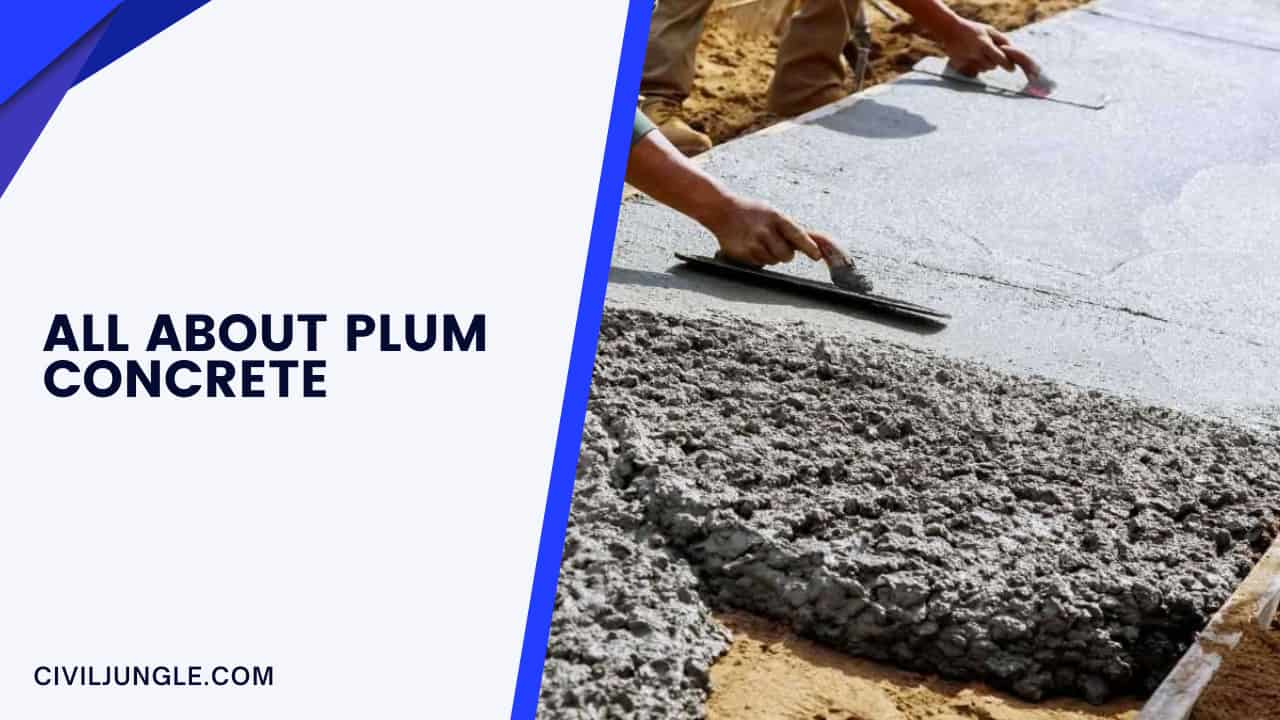
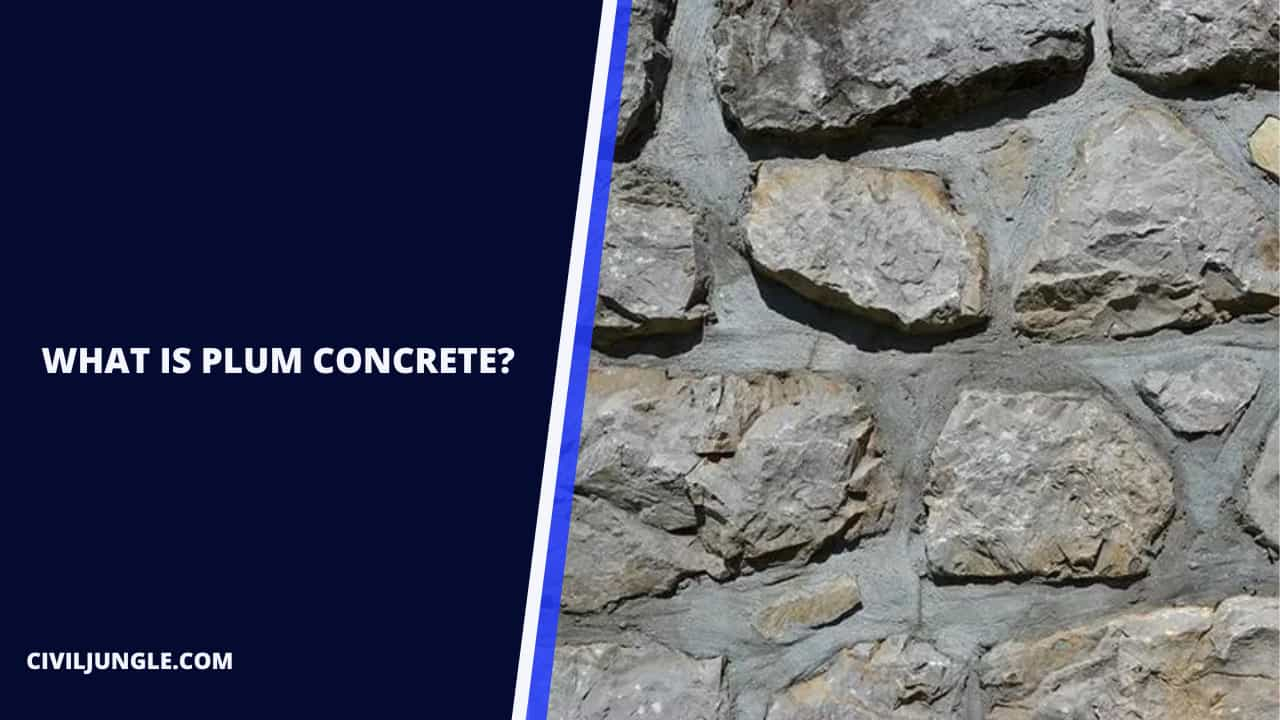
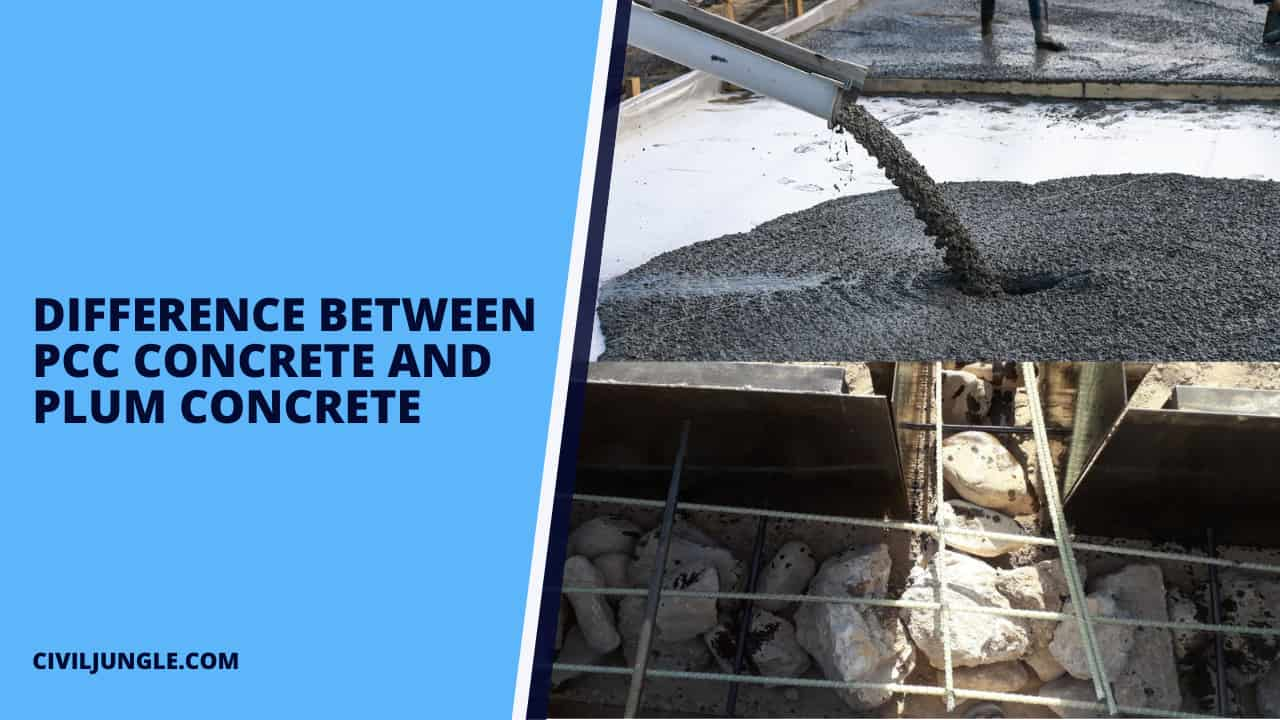
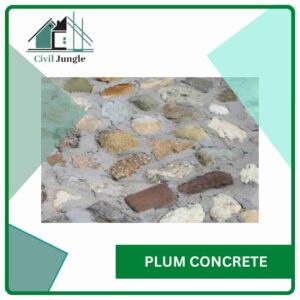
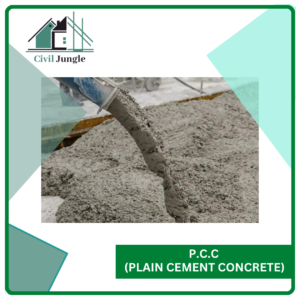
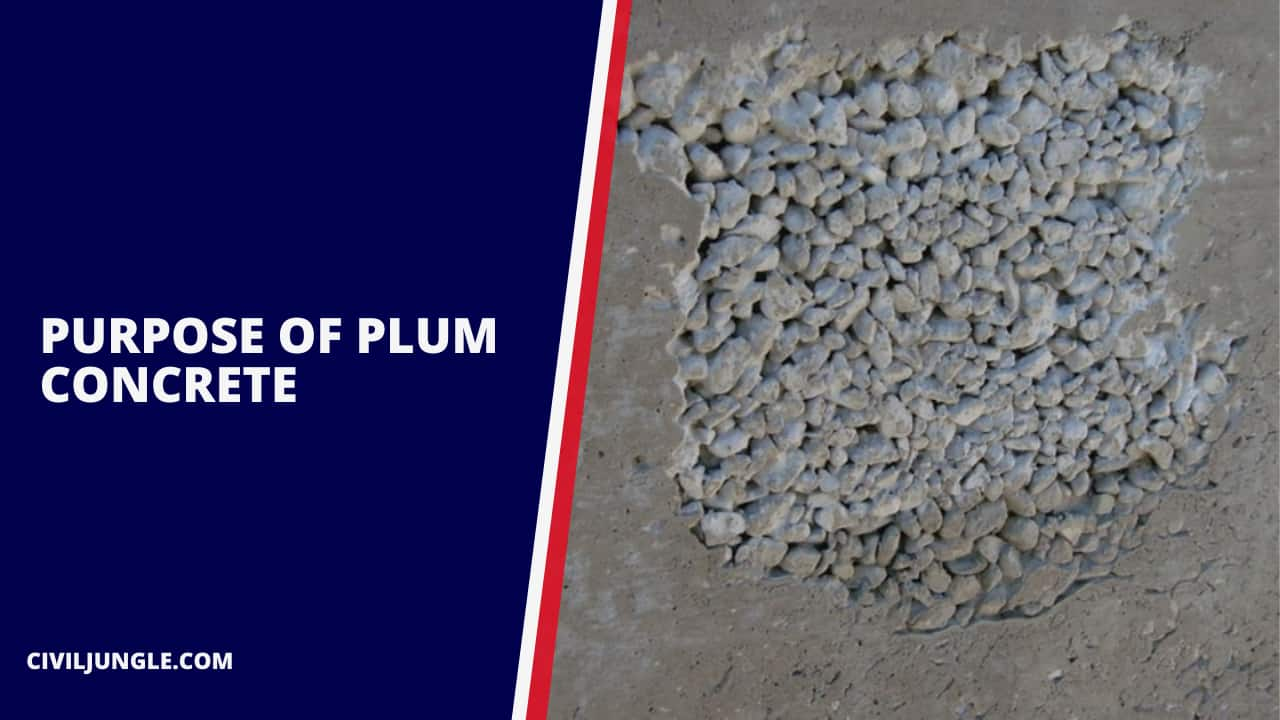
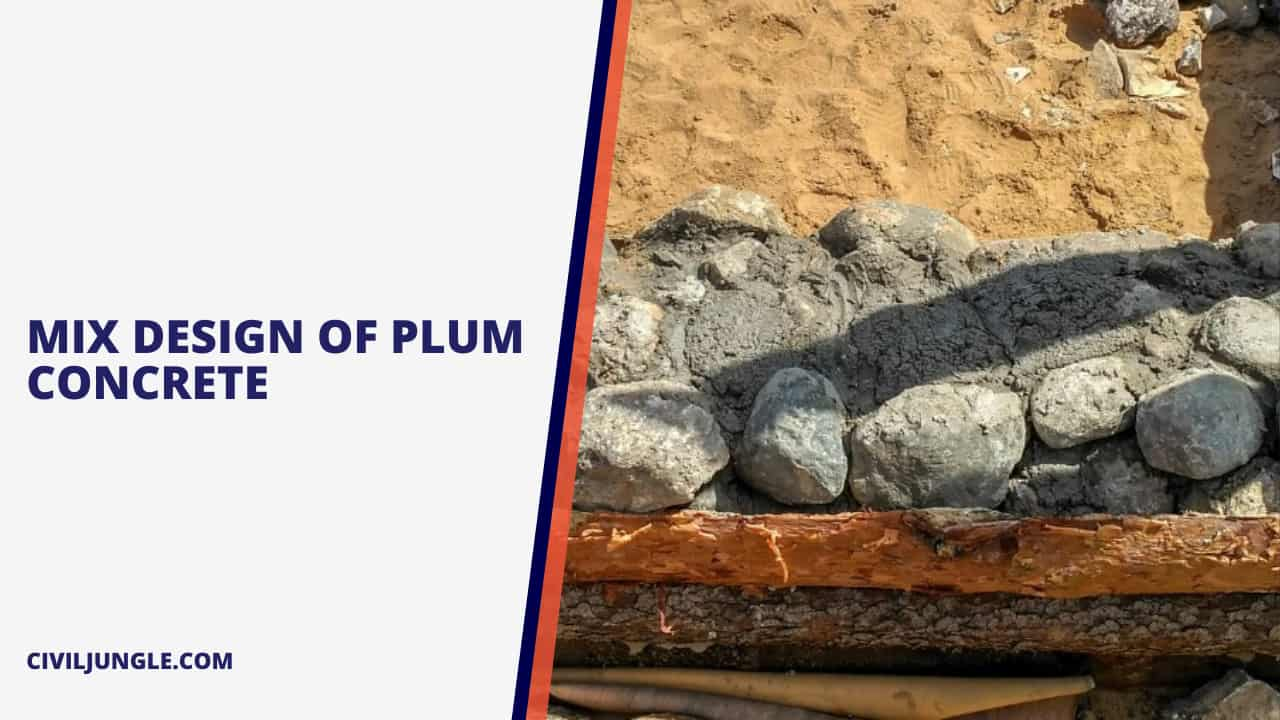
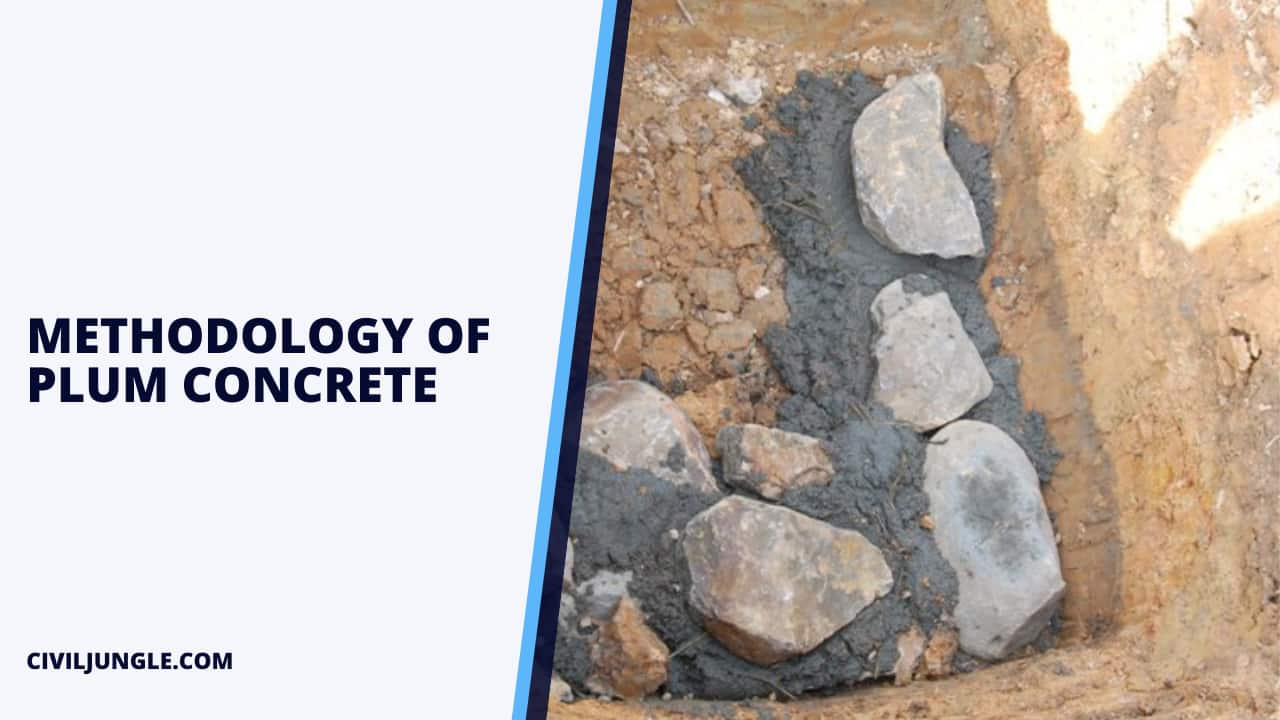
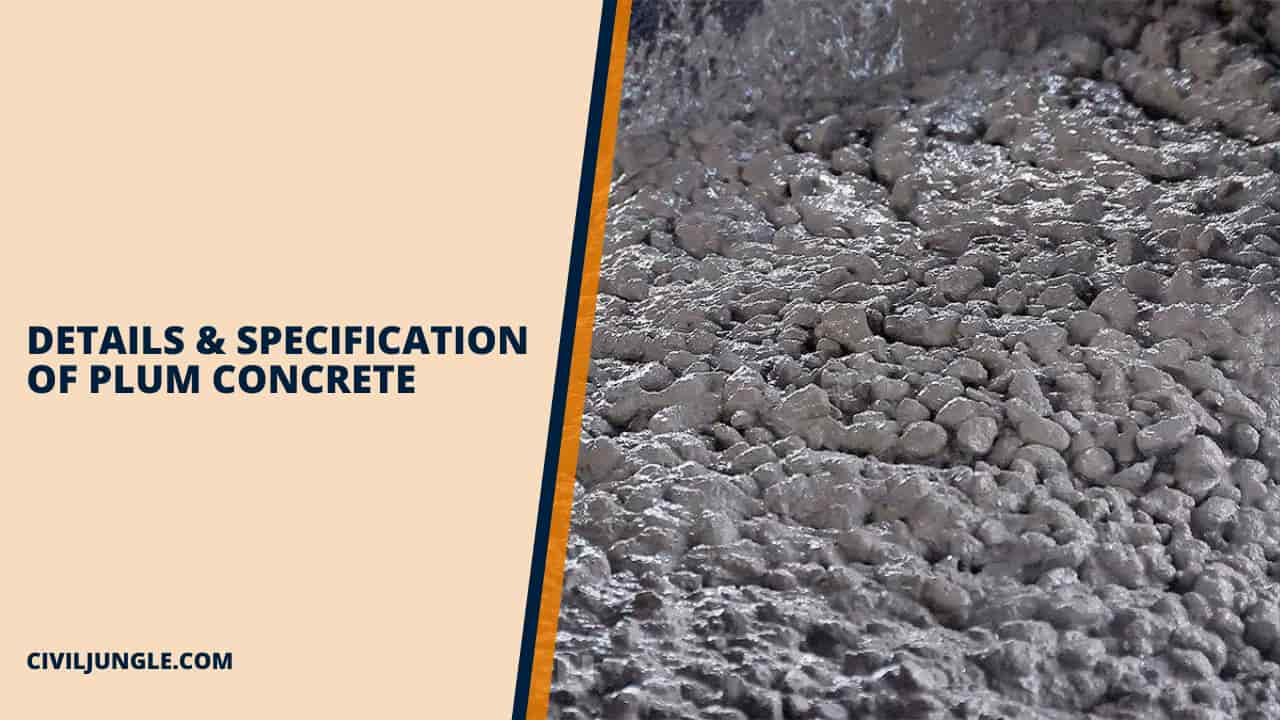

Hi to every one, the contents existing at this web page are actually awesome for people experience, well, keep up the nice work fellows.
“Plum Concrete can be utilized in areas that need massive concrete placements such as concrete dams or bridge piers. In these instances pieces of
Plum Concrete can ”
This line you have wrote two time in same line
Valuable article
Thanks,
For reading my article, and also thanks for showing my error.
Very good article for knowledge and economizing the construction cost. To use in National Highway projects IRC guidelines referring to use of plums concrete will be required. If you have any IRC reference related to plum concrete plz share.
I like the valuable information you provide in your articles.
I will bookmark your weblog and check again here regularly.
I am quite sure I’ll learn lots of new stuff right here!
Best of luck for the next!
Does a Vibrator is used in Plum Concrete?
Not required
What are the tests that can be performed on boulders that are to be used for plum concrete??
Thanks for additional knowledge.
Dear Sir,
Plum concrete concept is ok and acceptable in our working experience, but the main point is to be produced methodology of plum concrete in Road construction and fulfill and replacement of breast wall with client requirement because all code books are not explain more about Plum.
In view of above , my point is if any information about plum concrete as per codel practices is there in our IS codes please arrange it.